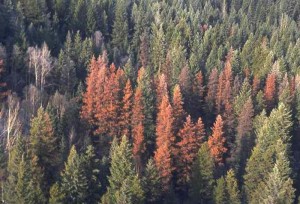Hikers, hunters and fall leaf lookers headed to the mountains in Colorado this fall should be aware that huge stands of lodgepole pines in beetle-killed areas are past due to fall at any moment, based on observations from Colorado State Forest Service foresters.
Ryan McNertney, a forester with the Colorado State Forest Service Granby District, says that although thousands of dead pines have already fallen over the past few years, foresters expect that rate to increase drastically this fall. “We’re seeing more trees snapping off at the trunk as they rot, rather than coming free at the roots,” he says.
State foresters have estimated that about 80% of Colorado’s lodgepole pine trees killed by mountain pine beetles will fall within a decade of dying, yet many lodgepole pine stands impacted by the beetles more than a decade ago have yet to fall.
“A lot of factors determine when an individual tree falls, including how long it has been dead, how much wind the site receives and how wet the wood remains over time,” McNertney says. “This combination of factors makes it difficult for foresters to determine exactly when a stand of trees might blow over, but they’re going to be coming down soon, wind or no wind,” he comments.
The CSFS offers the following tips to avoid harm from falling trees:
• Refrain from visiting forested areas in high-wind conditions or when strong winds are forecast.
• Remove standing dead trees in the vicinity of houses and other structures.
• If the wind picks up when you’re outside, move to a clearing away from dead or exposed trees.
• Locate campsites, parked vehicles and tents well away from dead trees.
• If possible, steer clear of remote roads that pass through beetle-killed forests, as trees falling across the road after your passage could block your exit.
• Pack a saw or chainsaw when headed into the back country to clear fallen trees from roadways.

